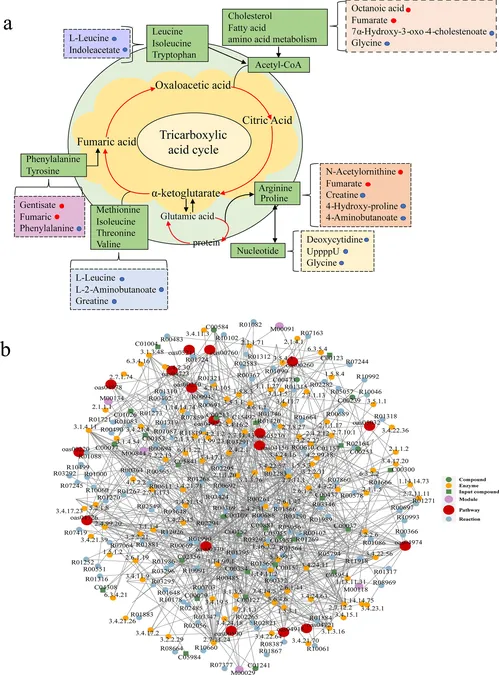
Unlocking the Mystery of Cystic Echinococcosis in Sheep: New Biomarkers Discovered!
2024-12-30
Author: John Tan
Background
Cystic echinococcosis (CE) is a life-threatening zoonotic disease caused by the parasitic infection of the Echinococcus granulosus tapeworm, with significant implications for both animal and human health. While ultrasound imaging and serological tests help diagnose humans, a pressing challenge persists in identifying metabolic markers in intermediate hosts, particularly sheep. This deficiency has seriously hindered efforts to control this parasitic menace.
Research Methodology
Recent groundbreaking research utilized ultrahigh-performance liquid chromatography-tandem mass spectrometry (UHPLC-MS/MS) to analyze serum samples from sheep infected with E. granulosus. By comparing these samples with those of healthy controls, researchers sought to identify distinct metabolic alterations associated with CE. Using advanced statistical techniques such as orthogonal projections to latent structures-discriminant analysis (OPLS-DA), the team uncovered a staggering **1,905 metabolites**, revealing critical pathways involved in the infection.
Key Findings
Among the significantly altered metabolites, **12 were notably upregulated** while **21 were downregulated** in infected sheep. Some identified metabolites, such as **1,7-dihydroxyxanthone and 2-methylbutyrylglycine**, demonstrated potential as reliable biomarkers (with an area under the curve [AUC] > 0.7), essential for early diagnosis and treatment strategies. The study illustrated that certain amino acid and fatty acid pathways were particularly disrupted in CE-infected sheep, with remarkable increases in fenugreek acid levels in these animals.
Beyond merely tracking the disease, this work shines a light on how E. granulosus manipulates the sheep's metabolic resources for its survival, confirming that the parasite relies heavily on the host's nutrients, further complicating the disease's control.
Epidemiological Context
Cystic echinococcosis remains endemic in various global regions, including parts of Africa, the Middle East, and western China. A startling report indicated that in 2022, **over 25,000 cases were recorded in China alone**. Furthermore, this disease poses an enormous economic burden, with treatment costs and losses in livestock reaching an estimated **US$3 billion annually**. Improving early diagnostic methods through the discovery of reliable biomarkers can have significant ramifications for public health and economic stability.
Pathological Insights and Clinical Implications
Through meticulous pathological analysis of impacted liver tissues, researchers confirmed the presence of hydatid cysts—a definitive hallmark of CE. This connection between metabolic changes and the observable health impacts reinforces the importance of integrating metabolomic data into conventional veterinary practices. Enhancing diagnostic accuracy could result in timely interventions, revolutionizing treatment plans and improving outcomes for infected sheep.
Looking Ahead: Future Research and the Fight Against CE
The identification of new biomarkers not only paves the way for more effective diagnostic techniques but also informs treatment strategies. With the parasite's complex relationship with its host underscored, future research will aim to explore novel therapeutic approaches targeting these critical metabolic pathways.
The ongoing efforts in metabolomics serve as a beacon of hope in the fight against echinococcosis, granting researchers invaluable insights into the intricate web of interactions between E. granulosus and its formidable host. As studies continue to unfold, the potential for automated diagnostic tools and tailored treatments looms large, offering prospects for eradicating this parasitic threat once and for all!

 Brasil (PT)
Brasil (PT)
 Canada (EN)
Canada (EN)
 Chile (ES)
Chile (ES)
 Česko (CS)
Česko (CS)
 대한민국 (KO)
대한민국 (KO)
 España (ES)
España (ES)
 France (FR)
France (FR)
 Hong Kong (EN)
Hong Kong (EN)
 Italia (IT)
Italia (IT)
 日本 (JA)
日本 (JA)
 Magyarország (HU)
Magyarország (HU)
 Norge (NO)
Norge (NO)
 Polska (PL)
Polska (PL)
 Schweiz (DE)
Schweiz (DE)
 Singapore (EN)
Singapore (EN)
 Sverige (SV)
Sverige (SV)
 Suomi (FI)
Suomi (FI)
 Türkiye (TR)
Türkiye (TR)
 الإمارات العربية المتحدة (AR)
الإمارات العربية المتحدة (AR)